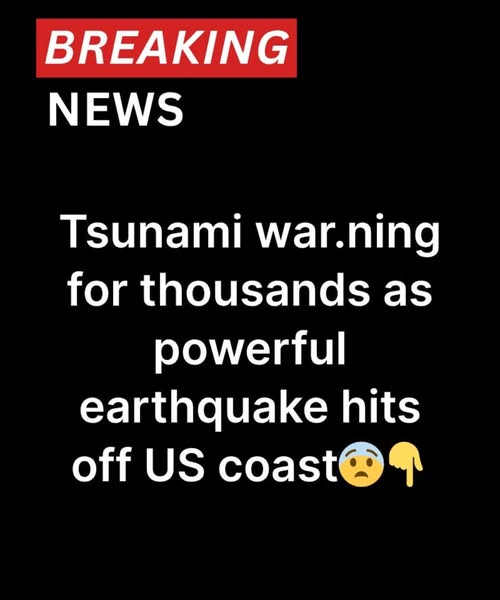
Wednesday’s afternoon tranquility along Alaska’s southern coast shattered when a powerful 7.3‑magnitude earthquake struck the Pacific floor just off the Alaska Peninsula. At 12:38 p.m. local time (4:30 p.m. ET), residents of Sand Point and nearby Shumagin Island felt the ground roll beneath them in a tremor so fierce that cellphone networks and emergency sirens sprang to life with urgent evacuation alerts.
By the time radios crackled with the word “tsunami,” thousands of people were already racing from seaside cabins, fishing docks, and the narrow spit of Homer’s Kennedy Entrance toward higher ground. Mayor Rachel Lord described bumper‑to‑bumper traffic as families, workers and tourists alike navigated winding coastal roads, determined to reach the safety of ridge‑tops and parking lots at least seventy feet above sea level. “Within minutes, you could feel the panic and resolve mixed together,” Lord recalled. “People were grabbing jackets, car keys, even backpacks meant for backpacks meant for day hikes—anything to get out of town fast.”
The National Weather Service quickly issued tsunami warnings for Kodiak Island, the eastern Aleutians and the Alaska Peninsula. In remote communities from Port Lions to False Pass, municipal water systems issued boil‑water notices as low‑lying homes emptied of residents. Meanwhile, NOAA’s publicly released bulletin map showed ominous red shading across nearly 700 miles of rugged shoreline, from the Aleutian chain’s Unimak Pass to forty miles southwest of Homer. For a moment, the region braced for history repeating itself—memories of the 1964 Good Friday earthquake and subsequent tsunami still vivid in the minds of many Alaskans.
Yet nature’s fury this time proved merciful. Coastal tide gauges recorded only a modest three‑inch surge at its peak—enough to draw back shallow beaches in the signature “drawdown” but far below the two‑to‑three‑foot rise that triggers dangerous currents. Within ninety minutes, the tsunami warning was downgraded to an advisory and then lifted entirely by 12:45 p.m. local time. Residents who had huddled in school gymnasiums at North Star Elementary or Kodiak High School began returning home, cautious but relieved that no towering wave had struck.
Still, the quake’s aftershocks kept nerves frayed. Over twenty smaller tremors, the strongest registering 5.2, rippled through the subduction zone where the Pacific Plate dives beneath North America at roughly two inches per year. “Four out of every five earthquakes in the U.S. occur in Alaska,” explained Michael West of the Alaska Earthquake Center. “This shoreline is one of the most seismically active in the world. What was unusual today wasn’t that we felt a big quake—it’s that we felt one and escaped a destructive tsunami.”
Scientists dispatched teams to assess shoreline changes and recalibrate tsunami‑models. In Kodiak, geologists measured subtle shifts in vertical elevation—parts of the island rose by millimeters as the Earth’s crust flexed and snapped back. Meanwhile, university researchers analyzed water‑sampling stations offshore, confirming that no hazardous undersea landslides had accompanied the quake.
Elsewhere along the Pacific Northwest, Oregon and Washington residents watched the news with anxious eyes but never faced an evacuation order. The National Weather Service reassured coastal communities from Newport to Westport that Alaska’s tsunami wave, if any, would arrive as imperceptible ripples. Mariners sailing the Gulf of Alaska noted only mild swell changes, evidence that the energy had largely dissipated in the deep ocean.
By evening, sense of normalcy began to trickle back to coastal towns. Fishermen returned to their boats, checking lines and trawl nets before casting off once more. Tour companies resumed glacier‑viewing cruises, and seaside lodges reopened their check‑in desks, greeted by travelers eager for a hot meal. In Homer, locals shared stories over steaming cups of coffee: some had fled in minutes, others had lingered on the bluff, curious whether the ocean would obey the warnings. All agreed, however, that Thursday’s sunrise felt especially precious.
In the coming days, state emergency managers will review the response, noting successes—like the swift activation of sirens and effective social‑media outreach—and identifying areas to improve, such as bolstering cellphone coverage in remote villages. Tribal councils in the Aleutian region are coordinating with geoscientists to enhance community‑based monitoring networks, ensuring that traditional knowledge of tides and wildlife behavior complements high‑tech sensors.
As Alaska’s residents reflect on Wednesday’s seismic scare, one thing stands clear: living on the edge of the Pacific Rim demands constant vigilance, preparedness, and respect for the forces that shape the land. Though the earthquake rattled nerves, it also reminded thousands why they built their homes here—bound by community, resilience, and the breathtaking beauty that only a wild, restless coast can offer.
